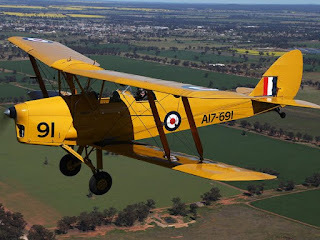Allen Tiller's Blog, page 14
March 1, 2022
The Shooting Death of E. Beckmann
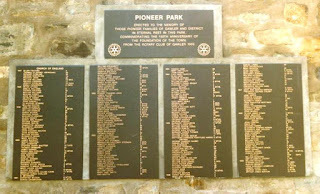
On Sunday 29 December 1850, E. Beckmann (sometimes published as Breckmond in local newspapers) was passing a house on the Gawler Plains, between Smiths Creek and Salisbury (in what would be Elizabeth today). As he passed one of the only houses on the plains, a hostile ferocious dog set upon him.
Beckmann went for his gun. Instead of shooting the dog, he attempted to keep it away by swinging the butt of the gun at it. Beckmann was holding the gun by the barrel end, he swung the gun meaning to slam it down onto the dog, smashing it into the ground. As the gun hit the ground it fired, sending its contents directly into Beckmann’s abdomen, shredding his insides.
The gunshot alerted nearby workers who found Beckmann. He lasted just half an hour before he died from the severity of his injuries.
The following day he was taken to Smith’s Hotel (now the Smithfield Hotel) for an inquest. Mr Bromley acted as chairperson, with members of the public acting as jury. It was discovered that Beckmann had on his person £1 5.s in money, a pocketbook, and a watch, so robbery was ruled out. After a short deliberation, Beckmann’s death was ruled ‘accidental’.His remains were taken to Gawler where he was buried in the Gawler Cemetery (now Pioneer Park).
There remains a mystery as to who Mr Beckmann was, with nothing found on his body to identify next of kin.
© Allen Tiller 2022
'Local News.', South Australian, (3 Jan 1851), p. 2., http://nla.gov.au/nla.news-article71685742.
'The German Constituencies in South Australia.', South Australian Register,(2 Jan 1851), p. 2., http://nla.gov.au/nla.news-article38442071
Pioneer Park – Gawler Old Cemetery Name List, Gawler History Team, https://drive.google.com/file/d/1-BRC....
February 21, 2022
Port Elliot UFO Sighting 1995
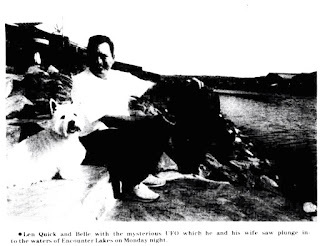
In 1995, Karen Lee of Port Elliot reported a UFO near her house. Her children called out to her because they were scared after seeing an object in the sky at about 7:10pm on Tuesday 29 August.
Ms Lee ran from the kitchen to view the object, which she described as “big, round and red.”
It hovered close to the family home, then sped away at great speed towards the ocean. Lee’s next-door neighbour, Ross Tuckwell also witnessed the UFO at about 7:30pm. Tuckwell was in his yard having a smoke when he witnessed what he described as a ‘huge floodlight’ that hovered over his Sorrento Parade home at Victor Harbor.
Len and Louisa Quick also witness orange lights. They spotted four orange lights the night before floating in a triangular formation. They watched the UFO’s when suddenly one floated down from the sky. Len kept his spotlight on the object and watched it descend into the harbour, and very close to where they were positioned. It did not take them long to realise the UFO was an orange garbage bag!
Only a few days later Victor Harbor police launched an investigation into the local UFO phenomena after a large orange garbage bag was found, partially deflated. Someone had turned garbage bags into sky lanterns.
The fuel for the ‘UFO’s’ was believed to be a firelighter suspended inside the bag with light wire.
The police did not find it funny, stating, "For sure it's dangerous, It's a really silly act. For one, it's stirred up all this UFO talk but more importantly if one of these devices landed in a field or something they could create a bushfire. Because of the danger, we would recommend that people not try to undertake any similar activity."
UFO mystery solved.
[1] 'UFO sighted', Times, (1 September 1995), p. 1., http://nla.gov.au/nla.news-article196384194
[2] 'UFOs all hot air', Times, (29 September 1995), p. 3., http://nla.gov.au/nla.news-article196...
[3] 'Police warn of danger', Times, (29 September 1995), p. 3., http://nla.gov.au/nla.news-article196....
February 15, 2022
The Haunting of the Exchange Hotel - Gawler
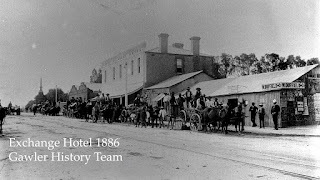
The Exchange Hotel was first licensed in 1868. On Saturday the 17th of May 1893, this hotel made national news after the suicide of R.F. Rankin. He had been wrongly prosecuted in Moonta for defrauding a chemist of 10 pounds.
Rankin came to Gawler intending to stay the weekend. Rankin had some bad habits, he was an intravenous cocaine and morphine user. On Saturday evening, Mrs Lucas, the wife of the publican heard some painful groans coming from Rankins room, she alerted her husband, who tried, but could not open the door. They called their ostler, who climbed a ladder and broke into the room, opening the door. There on the bed was Rankin, lying dead among syringes and tubes of cocaine. Doctor Dawes was called to examine Rankin…but it didn’t take long for him to realise it wasn’t an overdose, but a case of poisoning.
Found lying under the bed was a small bottle of prussic acid, which is also known as a solution of cyanide. It was used in fumigation and in mining, and the smallest amount can cause death instantly. Rankin had consumed about 15mls of the liquid. A jury concluded that most likely, Rankin was delirious from the amount of cocaine and morphine he had consumed, and possibly drank the bottle of cyanide without realising what he was doing. His death was listed as an ‘accidental suicide’.
It is claimed a female houseguest died upstairs and she is to blame for several of the ghostly goings-on inside the hotel. Scott Fraser, a former publican of the Exchange Hotel has previously stated in the media that lights will randomly turn on throughout the various levels of the hotel. Even more unsettling is the strong smell of death that permeates the rooms of the hotel with no known source.
Fraser had exterminators in twice, thinking a possum had died in the ceiling. After inspection, no source for the smell could be found, in fact, the smell seemed to move from room to room, and could sometimes be smelled in one corner of a room, and not another, as though an invisible wall was holding the smell in containment. The smell was bad enough that on some occasions people would choke, gag or vomit from it.
This hotel is also claimed to be haunted by the spirit of a little girl. It is not known whom she might be, but she is often seen sitting on a bed in an upstairs room!
Researched and written for the Gawler History Team presentation ‘Ghostly Gawler’ by Allen Tiller © 2021
'Coroners' Inquests.', South Australian Register, (30 May 1893), p. 3., http://nla.gov.au/nla.news-article48521216
‘Hydrocyanic Acid Formula’, Soft Schools.com, (2019), http://www.softschools.com/formulas/chemistry/hydrocyanic_acid_uses_properties_structure_formula/228/
'Coroner’s Inquests.', Evening Journal, (30 May 1893), p. 3., http://nla.gov.au/nla.news-article197868964
February 8, 2022
The Haunting of Euke House
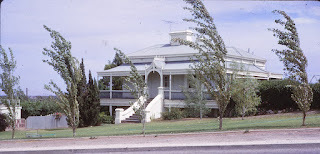
Euke House was built on land subdivided from Mahoney’s Paddock and another allegedly haunted house, Yenda, in Gawler.
The land was bought at auction by the farrier, William Wilson Smith in 1874. In 1875, Smith sold the land to the auctioneer who had sold it to him, Mr John Wilkinson.
Wilkinson is assumed to have built the house between 1875 and 1879. Wilkinson sold the property to Joseph Wilcox junior and William Roe Lewis in June 1879, it was sold again two months later to John Frederick May who was in a business partnership with his brother Alfred at iconic Gawler business the May Brothers. May leased the house to Edward Luca who bought the property in May 1894.
The property changed hands many more times, before becoming the home and medical surgery of Dr Gemmel Wilson Tassie in the 1960s until 1971 – and it is during this period that the alleged haunting began.
A cleaner in the home in the 1980s noticed that after she made the bed, the mattress would compress as if someone had just sat down. She noted sweet fragrances, in one bedroom, and every now and then, things would move around, she would walk in, place her cleaning items on a table, and a few seconds later, they would be on the other side of the room on a dresser. She never saw the spirits of the house, but claimed she felt that one room was haunted by a former doctor, another a former patient and that another spirit was a 'youngish' girl…could the girl be Gracie or Anna from Yenda?
This information was drawn from my talk for the Gawler History Team in 2021. You can watch the entire presentation via the video link below:
© 2022 Allen Tiller
February 1, 2022
A Haunting at the Royal Adelaide Hospital
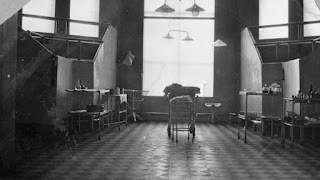
The foundations for the Royal Adelaide Hospital (now Lot 14) on North Terrace were laid in 1840, but it took until 1855 for the construction of permanent buildings to begin. These new buildings took a year to complete and contained a surgery, dispensary, nurse’s dining room, chapel, and a surgeon’s quarters. A two-story building was also constructed which featured inside it, padded cells and bedrooms.
A ghost story from the RAH comes directly from a nurse who was wrapping up a long night shift. The nurse was nearing the end of his shift and was running through the checklist of things to get done before the next shift started. He was tending to a patient who had just been pronounced deceased by the attendant doctor. The nurse washed the deceased man, completed the associated paperwork, then headed into the nurse’s station to await shift change.
While sitting at the station waiting for the shift to change over, he felt like he was being watched, then noticed a dramatic drop in the temperature of the room. He looked towards the doorway, and saw, standing there, the deceased patient he had just washed. The man was fully dressed, with a big smile on his face, and was waving, as if to say “Goodbye” to the nurse.
The nurse blinked his eyes in disbelief, and the man was gone... The nurse got up from his seat, ran across the hall into the room where the dead man’s body lay... and there he was, still laid out, still under his blanket, still deceased...
The RAH also has a story about a ‘Grey Nurse’ the story is the same as it is in most hospitals worldwide. No one really knows who she is, but the Grey Nurse does her duties in death, much like she did in life, delivering comfort to the dying. Could it be that these “Grey Nurses” are Angels from God, sent to comfort the dying?
© Allen Tiller 2022
(paranormal experiences are directly from the source)
January 25, 2022
Ghost Plane at Hawker
Mounted Constable L.F. Butcher of Hawker received several enquiries on Friday 26 august 1948 regarding a low flying Tiger Moth biplane that was seen at 8:15am, then disappeared!
Railway workers witnessed the plane flying low near the township when it suddenly disappeared into a hillside. Afraid there had been a crash, they alerted the local authorities.
Enquiries to the Civil Aviation Department found that all planes from as far away as Broken Hill, Whyalla and Albany were checked, and none matched the plane, nor its flight path. M.C. Butcher enquired with locals in the area, and no-one had seen, nor heard the aircraft flying in the vicinity of Hawker.
M.C. Butcher stated in the newspapers "It's a complete mystery."
The authorities would not believe a ghost plane could ever fly in our skies, so launched an investigation. It was widely rumoured that either a Tiger Moth or Puss Moth had been seen illegally flying somewhere near Beltana, South Australia. However, Mr A.V. Lauchland, an officer in charge of the Parafield Airport stated that there was no way the unregistered pilot could buy aviation fuel without a current registration. The Civil Aviation Department investigated through the Disposals Commission on the sales of light planes in the state.
238 km's south of Hawker, at Clare, Meggitt’s Ltd. was using a Tiger Moth to crop dust with DDT, fields around the Clare region. The same planes were being used in Queensland and New South Wales for the same purpose.
So perhaps, one of the Tiger Moths had made its way to Hawker as well?
It was never determined inf the Tiger Moth seen at Hawker was a ghost plane or an illegal pilot. However, a similar style of plane was once flown over the skies of Kapunda by my Great uncle. Long after his death, and the plane being sold and removed from the area, a phantom Tiger Moth has been seen silently flying over the township from time to time…
Researched and Written by Allen Tiller © 2022
'"Ghost" plane in north', News, (27 Aug 1948), p. 1., http://nla.gov.au/nla.news-article129....
'Is 'phantom' plane unregistered?', News, (28 Aug 1948), p. 1., http://nla.gov.au/nla.news-article129....
'Linseed Dusting in Clare District by Aeroplane', Northern Argus, (18 Nov 1948), p. 7., http://nla.gov.au/nla.news-article978....
January 18, 2022
The Burton Incident
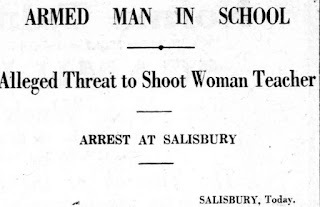
In 1927, the township of Burton was described by many as a hamlet on the road to Virginia from Salisbury. At the time, it had few houses, and a small school run by Miss Violet Handley.
On Friday 2 December 1927, Harry Bruce McDowell of Alberton, arrived at the Burton school early in the morning in a taxi. He found Miss Handley and entered the schoolroom, where they had a short conversation. He then left the room. Fearing the situation would escalate further, Handley dismissed the class, except for one strong lad. McDowell came back into the room and pushed Handley into a corner where he hit her repeatedly. He then pulled a revolver from his pocket and screamed at her, “I’ll shoot you and your mother as well!”
Handley pleaded to McDowell to be sensible and promised him she would meet him that evening to discuss matters. She gradually got up, and still talking to McDowell, led him outside to the taxi he had arrived in. She pleaded with the driver for assistance, as it looked as though McDowell was not going to leave. The taxi driver convinced McDowell to leave, and they left again for Adelaide.
Miss Handley, fearing that McDowell would return that day, posted some of her male students outside the school to keep watch for McDowell. Just after midday, he returned, asking the taxi driver to park further from the school.
One of the students alerted Miss Handley. Another student ran to a nearby farm to get help. Miss Handley ran from the school and locked herself in a room of the nearby Methodist Church.
Farmers, Mr White, and Mr Barcroft rode to the school on their horses, there they found McDowell outside the room Handley had locked herself in. He had in his hand a loaded revolver. Barcroft, disarmed McDowell, taking his revolver.
The police were notified, and Mounted-Constable T.H. Northridge of Salisbury arrived. He took the loaded revolver and a packet of bullets found in McDowell’s coat. He then charged him for threatening to shoot Miss Handley.
The case came before the Salisbury courts, where it was alleged that Miss Handley and Mr McDowell were long term friends. It was alleged Miss Handley’s mother had influenced her daughter to end the friendship, and therefore McDowell had become enraged.
Harry Bruce McDowell was charged with ‘unlawfully and maliciously threatening to shoot Violet Amelia Handley, schoolteacher, at Burton.’
The case was to be presented before Magistrates W.H. Neal and J. McGlashan. The prosecution read the charges, and as soon as they had finished, Miss Handley spoke; stating she had no intention of proceeding with the serious charges presented to the court, on that she withdrew, substituting instead, with a less serious charge of common assault.
She then presented that the accused had arrived at the school and grabbed her, then tried to kiss her. She had resisted.
McDowell in his evidence offered that he was extremely drunk at the time, and had no intention of harming Miss Handley.
The Bench inflicted a fine of £3, and costs, £8 7/6 in all.
Mr McGlashan, the presiding justice, said the case was the most unsatisfactory that he had ever had to deal with.
'Threatened To Shoot.', The Kadina and Wallaroo Times, (3 Dec 1927), p. 2., http://nla.gov.au/nla.news-article110144809.
"I'll Shoot You and Your Mother."', The Advertiser, (3 Dec 1927), p. 18., http://nla.gov.au/nla.news-article474....
"I'll Shoot You and Your Mother."', Chronicle, (10 Dec 1927), p. 68., http://nla.gov.au/nla.news-article900....
'Alleged Threat.', The Advertiser, (5 December 1927), p. 17., http://nla.gov.au/nla.news-article474....
'SCHOOL SENSATION.', The Register, (5 Dec 1927), p. 9. http://nla.gov.au/nla.news-article549....
December 21, 2021
Mallala Museum - Hidden Secrets
<start transcript>
In 1877, the Mallala Milling Company was floated with a capital investment of ten thousand pounds. A site in the township was chosen and James Martin and Co of Gawler were contracted to build all the machinery and carpentry for the new Mallala Mill.
The foundation stone was laid on 26 July 1878 by Miss M.A. Chivell, who was presented with a silver trowel for her efforts.
The Mill was opened by Mr W. Cavanagh M.P. on Tuesday 18 March 1879.
The completed building was three stories tall, built from hammer-dressed limestone, with brick quoins and cement dressings. At the rear was a shed that contained a Cornish boiler manufactured at James Martin and Co in Gawler. The boiler drove a horizontal engine of 22 horsepower, with a flywheel weighing three tons.
The mill consisted of three pairs of French burr stones, each being 3 feet and 8 inches in diameter.
On 31 August 1880, just after 12 noon, the boiler at the Mallala Mill exploded. Mr Armfield, the Mills engineer had just been to check on the boiler and returned to the engine room when the accident happened. The boiler exploded, blowing down half of the boiler-house walls and bursting numerous pipes. The explosion blew the roof of the engine and boiler room houses and shattered the base of the chimney stack. Luckily, no one lost their lives, as most workers had gone to lunch, however, Mr Armfield received some head injuries from flying debris
When the mill closed, the inner workings, the steam engine and grinder were removed and used at the Blyth Mill.Mathew Henry East held the title in 1909, and in 1933, East Brothers and Co took possession
In 1947 the 50-foot-tall chimney, made from over 6000 bricks, that had been built in 1878 was demolished. It had been declared unsafe and a risk to the buildings nearby
The Mallala and Districts Historical committee was formed in 1968, and in 1970, the Adelaide Plains Council bought Mallala Flour Mill to be used as a museum. The museum holds a comprehensive military display of local involvement, farming machinery, an REO Speedwagon Fire Engine, displays of old typewriters, toys, blacksmith forge, and Mr Temby’s penny-farthing, which was ridden in the Adelaide Xmas Pageant by Lance Tiller. The Long Plains Schoolroom has many displays, and recently, in 2021, a new upstairs gallery was opened and dedicated to long term volunteer, the late Margaret Tiller.
The Mallala Museum is considered one of the finest local heritage museums in South Australia. It is open every Sunday afternoon from 2pm until 4:30pm and is run by volunteers. <end transcript>
© 2021 Allen Tiller
[1] 'Laying the Foundation Stone of Mallala Flour Mill', Yorke's Peninsula Advertiser, (6 August 1878), p. 4.
[2] 'Opening of the Mallala Mill.', South Australian Register, (20 March 1879), p. 1.
[3] 1947 'Out Among The People', The Advertiser (Adelaide, SA : 1931 - 1954), 15 April, p. 4. , viewed 14 Aug 2021, http://nla.gov.au/nla.news-article305...
December 14, 2021
The Murder of James Curran.
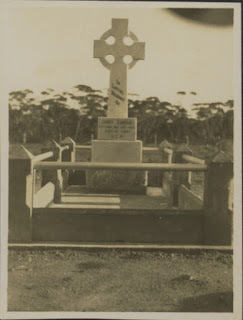 Grave of James Curran - SLSA [B 28120]
Grave of James Curran - SLSA [B 28120] James Curran worked at Minnipa on South Australia’s Eyre Peninsula. He was employed by the Hydraulic Engineers Department, working on constructing a holding tank for the Tod River water scheme in 1927.
On Sunday morning, 30 January 1927, Curran had a drink of coffee before breakfast and became ill.
Before he died and in throes of agony, Curran spoke to the foreman, H.E. Scott. He gave the address of his daughter at Warrnambool, but before he got to speak his son’s address, he died.
It was believed that poison had been put with sugar that Curran had used to sweeten his coffee. Police constables Hann and Cain investigated. They found that a cook from the construction camp had suicided six months earlier and that recently two pigs, who had eaten scraps from the camp dinner, had also died. Further investigation was sought.
An inquest was held under the watch of Dr McCarthy of Wudinna, ordered by Coroner A.G. Collyer-Braham.
At the inquest, Charles Jones, the assistant cook gave evidence of the morning of Curran’s death. He said that at 7:30 am Curran came into the kitchen with a pannikin. Jones put coffee and sugar in it. Curran remarked to Jones, “What did you out in this? You are always putting jokes upon me.”
Jones replied that he hadn’t put anything in it. Curran asked him to taste it, so he took a teaspoon full, which Jones thought tasted bitter.
Curran threw out his coffee and was poured a new one. A short while after drinking it, he shouted “I am poisoned!”
Another witness, Walter Rowe, a Deputy Government Analyst, stated that he examined the 3 oz. of sugar in the container. In it, he found a ½ grain of strychnine. There was no poison in the sugar bag in the storeroom. He also examined Curran’s liver and kidneys and found enough of the poison present to deliver the fatal blow.
More witnesses were called, and a suspect pointed at. Frank Styrmin recalled that he had handed a bottle of strychnine to a man named Schultz who was with Carl Bystedt. A suspect had been found.
Based on circumstantial evidence, Carl Eugene Elwing Bystedt was committed for murder. Coroner A.G. Collyer-Braham stated that the evidence against Bystedt was strong. He commended Detectives Slade and Golds on their investigation into the case and their collection of evidence, which met with difficult circumstances due to a large portion of the workers at the camp being foreigners whose first language was not English.
Coroner Collyer-Braham stated,
“That James Curran came to his death on January 30 at mess camp at Minnipa through strychnine poisoning, after having drunk a cup of coffee, in which was mixed sugar containing strychnine.' He stated that the evidence against Bystedt was so strong that he must face the jury at the next sitting of the Criminal Court.”
Bystedt was taken to Adelaide to face charges. The South Australian Crown Solicitor, A.J. Hannan, investigated the case and decided that there was barely any evidence that pointed toward Bystedt being the murderer. As there was no case, Bysted walked a free man.
James Curran is buried in the Minnipa cemetery.
© 2021 Allen Tiller.
[1] 'Poisoning Case at Minnipa.', West Coast Sentinel, (4 February 1927), p. 1., http://nla.gov.au/nla.news-article168....
[2] 'Minnipa Inquest.', The Register, (23 February 1927), p. 15., http://nla.gov.au/nla.news-article548....
[3] 'Minnipa Tragedy', Barrier Miner, (24 February 1927), p. 4., http://nla.gov.au/nla.news-article459....
[4] 'Minnipa Tragedy.', The Register, (25 February 1927), p. 9. http://nla.gov.au/nla.news-article548....
[5] 'No Indictment.', The Armidale Chronicle, (9 April 1927), p. 6., http://nla.gov.au/nla.news-article188....
[6] 'Minippa Tragedy.', Recorder, (8 April 1927), p. 1., http://nla.gov.au/nla.news-article958....
December 7, 2021
The 1855 Macclesfield Murder.
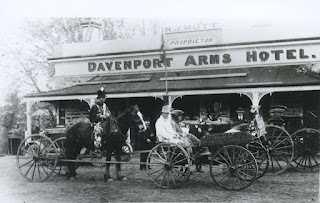
Davenport Arms Hotel 1921 – SLSA [B 34161]
On Monday the 24th of September 1885, an inquest was held at the Davenport Arms, Macclesfield after the murder of a local man named James Spencer.
On the Friday prior, Spencer had been seen by locals, dressed in his best clothing at about 7pm in the evening, after voting in local elections. He returned to his small home about three-quarters of a mile from the town.
Spencer lived by himself. A neighbour, Mr Crick, noted that no smoke left his chimney on the Saturday and Sunday, something that in 1855, would have been a regular occurrence anytime someone cooked, or even wanted to boil the kettle, being as there was no electricity or modern conveniences.
Crick went over to check on his neighbour and found the old man had been murdered.
The police were called immediately, and upon inspection, locked the door of the house so any potential evidence would not be corrupted. He then informed the local magistrate and went about examining the home.
At the inquest, it was revealed that Spencer had been stabbed twice in the chest, and three times in his side. He had been left to bleed out. Spencer’s blood covered his body and much of the interior of the hut. Near his body was a washbasin filled with water, where the murderer had washed his hands.
After the announcement of his murder in local media, a story was published in the South Australian Register about Spencer’s life by his former employer. It was revealed that Spencer was a ‘ticket-of-leave’ man, a former prisoner at Tasmania, sent from Oxfordshire, England.
Spencer had lived in poverty in his younger days, and worked as a chimney sweep.
Spencer had a grand idea one day. He decided to descend into a house through the chimney and rob it. On his way back up he got stuck in the chimney. He tried to escape but wedged himself tighter, he had no choice but to call for help. When help did arrive, a large section of the brickwork had to be removed to free him. His loot was discovered, and he was arrested, sentenced, and sent to Van Diemen’s Land.
The author of the description did not know what Spencer was like, nor how long he served during his time in Tasmania’s gaols. However, he stated that Spencer had,
“Sacred veneration for what he termed his word of honour. His word was literally his bond, and his integrity in fulfilling his encasements was unimpeachable, lie was a man of a charitable disposition, and was ever ready, as far as his scanty means would admit, to assist those who were in need, while with scrupulous pertinacity he would avoid incurring an obligation himself.”
It was also written that Spencer was not keen on socialising. He kept few friends, never married, and kept to himself as much as possible.
The author of the letter addressing the character of Spencer was Mr E. Holthouse, of South Terrace Adelaide. He went on to describe that he had recently employed Spencer as a log splitter. He stated that Spencer was physically strong and that he believed the person in the hut had been caught by Spencer, who tried to stop the infiltrator from robbing him, resulting in his murder.
The police never found the murderer, and in a statement published in the Adelaide Observer, the South Australian Police Commissioner of the day said: "society is unable to avenge the death of one who had almost entirely withdrawn himself from her circle."
A curious statement, that may hint at the possibility the police were not going to waste their time on an ex-convict’s death.
After the inquest, the jury returned the following verdict of: “Wilful murder against some person or persons unknown.' The deceased was a single man, about 50 years of age, and followed the occupation of a splitter.”
Spencer’s belongings and property were sold in January 1856 at auction.
[1] 'Declarations.', South Australian Register, (28 September 1855), p. 2., http://nla.gov.au/nla.news-article49294447.
[2] 'The Macclesfield Murder.', South Australian Register, 95 October 1855), p. 3., http://nla.gov.au/nla.news-article492....
[3] 'The Police Report.', Adelaide Observer, (17 November 1855), p. 6., http://nla.gov.au/nla.news-article158....
[4] 'No title', South Australian Register, (26 September 1855), p. 2., http://nla.gov.au/nla.news-article492....
[5] 'Advertising', Adelaide Times, (29 December 1855), p. 4., http://nla.gov.au/nla.news-article207....

